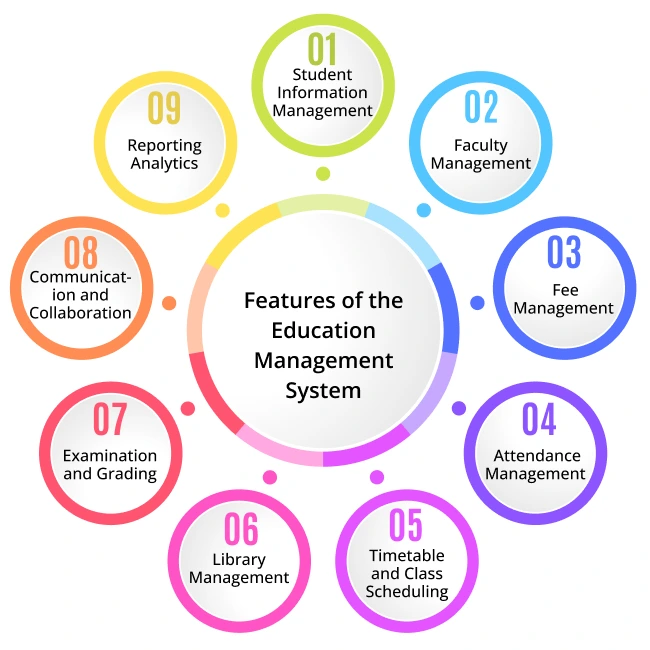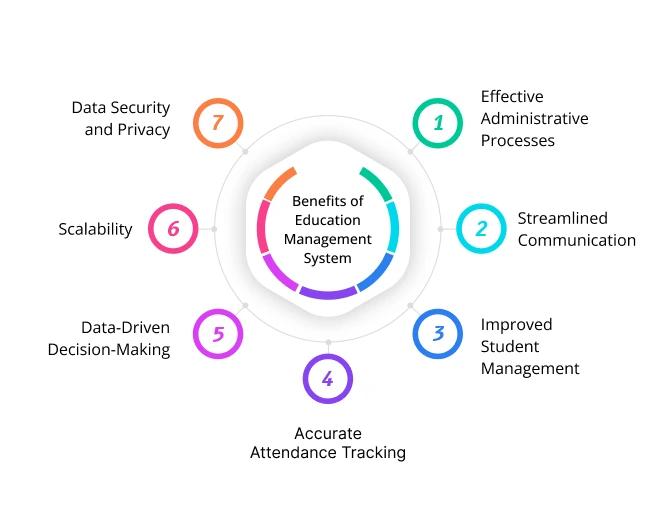16, Sept 2024
Maintaining attendance, making lesson plans, and tracking individual student progress simultaneously is challenging. In fact, managing administrative and teaching/learning activities while ensuring efficiency is demanding.
Technological integration, with the help of tools like education management systems, can help institutes establish and sustain smooth functionality. In effect, it reduces manual effort and effectively automates data collection, sharing, and maintenance.
What is an education management system?
An education management system, or EMS, is a multi-functional software solution that has been designed to manage different aspects of educational institutions. It includes various modules to manage student information, enrollment activities, attendance management, etc.
Also, it deals with timetable scheduling, examinations, library management, and more; EMS streamlines all the aforementioned functions through a centralised platform. As a result, it leads to the elimination of redundant, manually intensive processes, ensuring data consistency across the institute.
Furthermore, it automates and centralises administrative tasks, enabling educational institutions to focus on core academic objectives. At the same time, it provides a seamless experience for students, parents, and administrative staff.
Evidently, the education management system is a significant software solution that impacts every aspect of an institute. Therefore, it is only fitting to take a look at some of its crucial features.

Features of the Education Management System
1. Student Information Management
Educational institutes face challenges in handling a multitude of data manually; that is where the student information management module comes in. It has a centralised database that stores comprehensive student records, including personal details, contact information, academic history, attendance, and disciplinary actions.
Besides, students can access their academic records, attendance, and fees through the student portal and communication platform.
MasterSoft: A College Attendance Management System Made Simple
2. Faculty Management
It is equally important for institutes to organise faculty-related information accurately to track and evaluate their performance. EMS helps to effortlessly maintain the detailed records of teachers, administrators, and support staff.
For instance, the streamlining of qualifications, personal information, assignments, and experience becomes easy. Also, they can use the tool to execute salary calculations, tax deductions, and other payroll-related tasks.
The institute management can use the faculty management module to facilitate performance appraisals, set goals, and track professional development.
3. Fee Management
Establishing and maintaining accurate fee transactions is a crucial part of the institute’s financial management strategy. Thankfully, they can use education management software to carry out various fee-related operations.
For example, they can define different fee categories, discounts, and payment plans; also, tracking fee payments and generating receipts gets easier. Moreover, the tool sends out reminders to students and parents about the upcoming fee deadline and generates overdue notices.
4. Attendance Management
Manual recording and tracking of attendance is tedious and time-consuming; on the contrary, auto-recording through the system is an efficient mechanism. On the other hand, it tracks staff attendance and generates accurate reports accordingly.
In addition, it sends notifications and alerts of absences and unauthorised leaves and keeps a record of the same.
5. Timetable and Class Scheduling
The system facilitates class scheduling, depending on teacher availability, room capacity, and student preferences. What’s more, it helps to plan and organise exams, including timetables, seating arrangements, and invigilator allotment.
Simultaneously, it streamlines the room allocation according to particular examinations, subjects, and student batches.
6. Library Management
Libraries are the knowledge hub of schools and colleges and cater to students' requirements from time to time. However, maintaining an in-house library is a challenging task; that is where the EMS can help catalogue a comprehensive database of books, journals, and other library resources.
In addition, it can assist in tracking the issuing and borrowing of books, and it also manages library memberships and user privileges.
7. Examination and Grading
The software automates the pre- and post-examination procedures effectively; for example, it generates question papers, answer keys, and rubrics. Furthermore, it has an auto-calculation mechanism, helping to calculate and publish student results.
Teachers don’t have to spend time and effort managing grades and scores manually, as the tool automates gradebook management. In effect, students can record and track their grades and performance effectively.
8. Communication and Collaboration
The system comes with built-in communication channels, facilitating smooth communication between parents and teachers via SMS, email, and online portals.
In fact, students can interact with teachers in real time and ask questions and solve queries; they can also discuss assignments. Teachers can provide feedback on students’ work and highlight their strengths and weaknesses.
Also, institute team members can communicate with each other through messages and notifications and avoid any miscommunication.
9. Reporting Analytics
Teachers and administrators can generate customisable reports on student performance, attendance, fee collection, and other vital metrics. As a result, the faculty can obtain insights into students’ progress, attendance patterns, and other trends.
Faculty and institute management can track the performance of the overall class through the dashboard, offering a centralised view of Key Performance Indicators (KPIs).

Benefits of Education Management System
1. Effective administrative processes
The Education Management System (EMS) simplifies administrative processes by automating them, which enhances efficiency and improves overall management. It provides a centralised repository for student and institutional data.
As a result, it eliminates data redundancy and improves data accessibility, enabling faculty and stakeholders to obtain information conveniently. Furthermore, it automates other key administrative functions such as fee collection, attendance tracking, report generation, etc.
2. Streamlined Communication
The software provides a common communication channel for students, parents, and teachers to communicate properly and stay updated. Moreover, they receive updates about assignments, announcements, and events.
It can help establish a collaborative environment through useful features like messages, email notifications, and bulletin boards.
3. Improved student management
The system assists teachers in improving their teaching and learning experiences, enabling them to develop personalised learning pathways. In effect, students encounter diverse, active, and experiential learning approaches.
What’s more is that they can streamline academic progress, attendance records, and performance evaluations efficiently.
Simplify Institute Tasks: MasterSoft's Student Management System
4. Accurate attendance tracking
Manual attendance recording and tracking is a time-consuming and tedious process that the software automates efficiently. Consequently, digital recording of attendance saves time and effort, helping to store information that parents and teachers can check accordingly.
Besides, it generates attendance reports, helping to identify trends and take necessary steps to improve student attendance.
5. Data-Driven Decision-Making
EMS stores and compiles the institutional data systematically through dashboards and reports, enabling the admin to check it periodically. In effect, they get actionable insights to make changes in certain administrative processes.
On the other hand, teachers can view the reports to carry out timely interventions for at-risk students and identify patterns in academic performance.
6. Scalability
The software has high scalability, enabling institutes to accommodate students, teachers, and resources accordingly. Therefore, it helps to streamline admissions and examinations effortlessly without any technical issues.
7. Data security and privacy
The software ensures data security and privacy with the help of access controls, encryption, and secure authentication measures. Hence, authorised personnel can access confidential information, and it prevents unauthorised access.
Therefore, it effectively eliminates the risk of data breaches, cyber-security threats, and data theft.
Institutes might want to employ the tool due to its varied advantages; however, it is essential to be aware of the crucial steps before its implementation.
Factors to Consider While Implementing an Education Management System
1. Need Assessment and Software Selection
The first step is to identify the specific challenges that institutes face in their administrative processes and identify essential features that can help address them. The next step entails researching and comparing different EMS options, depending on their features, pricing, scalability, and reputation.
Finally, one can choose a software vendor that aligns with the institute’s goals and budget.
2. Data Migration and Preparation
The institute administrator must assess the existing data, its format, and its accuracy, and ensure which ones are necessary and which ones are redundant. Then, they need to establish a clear mapping between the old system and the new EMS. Also, they must transfer data accurately and securely to the new system.
3. System Configuration
An institute’s team members can customise the system to match their workflows and processes; they can integrate with other systems (e.g., accounting, HR) if necessary. Also, it is necessary to set up security mechanisms to protect sensitive data and conduct tests to identify and solve issues.
4. User Training
Institutes must conduct comprehensive training programmes for all user groups (administrators, teachers, students, and parents). Furthermore, they can provide practical training sessions and workshops and establish a dedicated support system to address user queries and issues.
5. Implementation
Phase-wise implementation is a good strategy as it helps test the system in a controlled environment. After verifying the accuracy of the migrated data, the admin can schedule a go-live date and communicate it effectively to all stakeholders.
In addition, the team must evaluate the initial implementation and determine the areas for improvement. Furthermore, institutes must choose a vendor that provides ongoing technical support to the users and keeps the EMS up-to-date with the latest features and security patches.
Conclusion
Education management systems are indispensable tools that help streamline administrative processes and enhance communication between students, teachers, and parents. While there may be challenges in its implementation, the long-term benefits of improved efficiency, collaboration, and data management outweigh these issues. As a result, EMS is becoming a key component of modern educational institutions.
Simplify your faculty hiring process with MasterSoft’s faculty management system.
Mobile: 08448010216
Email: janki.somani@iitms.co.in













